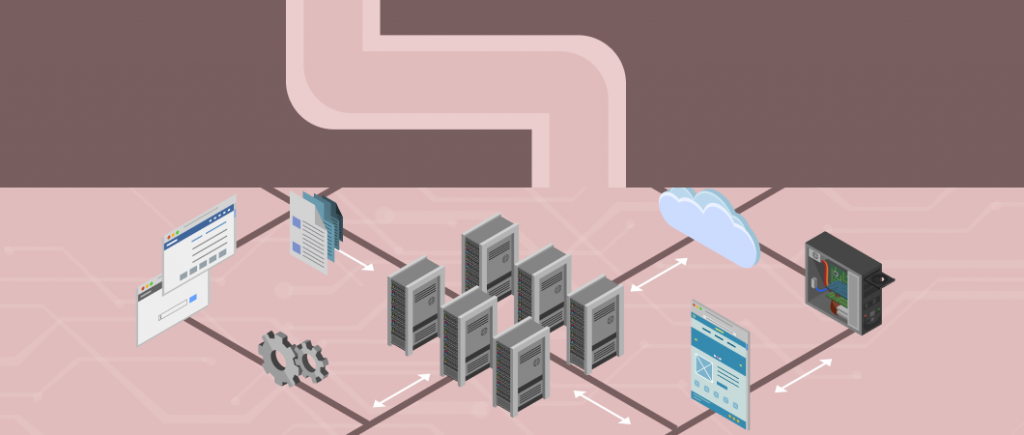Last updated on April 30th, 2024
Can you build anything of value without a strong foundation? The loftiest building stands because of its deep and solid foundation. The house of cards crumbles because of the lack of it. The world of software products is no different. A great software product stands on the strength of its architecture. It also falls, because of it.
Why talk about product architecture?
At a high level, software product architecture is the plan that defines the set of aspects and designs essential to the software. The architecture takes into consideration aspects such as performance, security, scalability, functionality…pretty much everything that makes that software tick.
It is the software architecture that decides how and how well the system parts communicate with each other, what the external dependencies are, what will be the guidelines of the technical implementations, the risks to factor in and so on.
As we said, software architecture includes decisions. How easily can you change an aspect of the software, add or deduct from it, update it or upgrade it? Would there be a huge impact when you decide to implement any change? Would it be hard to manipulate this change?
Reasons why software architecture is important?
Software architecture plays a pivotal role in the success of any software project, offering a roadmap for development teams to follow. Firstly, it establishes a solid foundation upon which the entire development process is built, providing clarity and direction from the outset. Scalability and flexibility are critical aspects of software architecture, enabling systems to adapt to evolving requirements and scale effortlessly. Moreover, a well-architected software system is easier to maintain and extend, minimizing the complexity of future modifications and enhancements. Performance optimization is another key benefit, ensuring that the software operates efficiently and meets performance expectations. By addressing these aspects, software architecture not only reduces development risks but also contributes to cost-effectiveness by streamlining the development process and minimizing the need for costly rework. Ultimately, investing in software architecture is essential for creating robust, maintainable, and scalable software solutions that meet both present and future needs.
Foundation for Development:
Software architecture serves as the blueprint for the entire development process, providing a structured framework that guides the design, implementation, and maintenance of a software system.
Scalability and Flexibility:
A well-designed architecture allows for scalability, enabling the software to accommodate growing demands and changing requirements without requiring a complete overhaul. It also provides flexibility, allowing for easier integration of new features and technologies.
Maintainability and Extensibility:
Clear architectural decisions contribute to the maintainability of a software system, making it easier to identify, understand, and modify individual components without affecting the entire system. Moreover, an extensible architecture supports the addition of new functionalities without significant rework.
Performance and Efficiency:
Properly designed software architecture can enhance performance by optimizing resource utilization, minimizing bottlenecks, and streamlining data flow. It ensures that the software meets performance requirements while utilizing resources efficiently.
Risk Management and Cost Reduction:
A solid architectural foundation helps mitigate risks associated with software development by identifying potential issues early in the process. This proactive approach reduces the likelihood of costly rework and ensures that the final product meets quality standards within budget and time constraints.
A great software architecture contributes the following to development
A great software architecture serves as the backbone of any development project, providing essential benefits and laying the groundwork for success. Here are some key points on how it contributes to development:
Scalability:
A well-designed architecture accommodates growth and change, allowing the system to scale seamlessly as user demands increase or new features are added.
Maintainability:
Clear separation of concerns and modular design principles make it easier to maintain and update the software over time, reducing the risk of technical debt and enhancing long-term viability.
Flexibility:
A flexible architecture enables developers to adapt to evolving requirements and integrate new technologies without requiring extensive rework, promoting agility and innovation.
Performance:
Optimized architecture can significantly improve system performance, ensuring responsiveness and efficiency even under heavy loads or resource constraints.
Reliability:
Robust architecture enhances system stability and resilience, minimizing downtime and mitigating the impact of failures or errors through effective error handling and fault tolerance mechanisms.
Security:
By implementing security best practices at the architectural level, such as access controls and encryption, software architecture contributes to safeguarding sensitive data and protecting against cyber threats.
Collaboration:
Clear architectural documentation and well-defined interfaces facilitate collaboration among development teams, fostering communication and alignment towards common goals.
Cost-effectiveness:
Investing in a solid software architecture upfront can yield significant cost savings in the long run by reducing rework, improving efficiency, and minimizing the risk of project failures or delays.
Software architecture and the black hole of Technical Debt
‘Technical Debt’ is almost like a curse of the Agile way. The quest for building fast and releasing often places a burden on the software architect. The architect is called upon to begrudgingly design the bare minimum…the minimum viable architecture. The thing is, agile teams, recognize the need for a strong architecture but often ‘go-to-market’ is the enemy. (Read more: A 5 Step Approach To Auditing Your Technical Debt)
Design artifacts for the best, the most-perfect software architecture can be a drag when all the development team wants to do is get the working software out of the door. So, what do they do? They get a ‘good enough’ architecture in place. But it is this ‘good enough’ architecture that paves the way for ‘technical debt’.
We suggest that when it comes to software development, technical debt comes in two types. Let’s call them Type 1 and Type 2.
Type 1 is when the code is just bad. This has to be avoided under all circumstances (well, obviously). The second type, Type 2, refers to the intentional shortcuts designed to help the code to work. This code will require refactoring in the future iterations. Such code usually has an intentional lack of functionality or intentional design simplification to reach a short-term goal in a manner that it can also facilitate future iterations easily.
Well planned technical debt (type-2) is an essential part of agile software design and is, in fact, necessary.
This of this like how borrowing money when you want to buy a house can be a good thing. However, you have to ensure that your future monthly payments are manageable and that the interest does not cripple you and later, your house increases in value. This is well-planned debt. And the same applies with software architecture and technical debt.
Software architecture and the evolving expectations conundrum
Change has now become the norm in the world of software product development. It’s not just new technologies or stellar new languages influencing these changes. Even data is making a big impact in the development landscape. Users want elevated, intuitive, frictionless experiences. The forces of globalization are expanding markets and consequently also increasing competition.
You need to cater to the needs of the user even before the user identifies the need. That’s how great software products are built today. That’s how they stay successful.
Unless you focus on continuously enhancing your products’ features, unless you drive exception customer experiences, your product will easily be replaced. Do you remember Orkut? Probably not, because Facebook replaced it.
Now, to stay in step with this climate of constant change, we have to focus on software architecture. The business goals of a product determine the features and quality attributes of the product and the feature and quality attributes of the product determine the architecture.
An analysis of the architecture helps in identifying and reducing risk. It also serves as a foundation to develop a product that is ‘built to change’ rather than ‘built to last’. It takes into consideration:
- The Functionality of the software and its performance against the intended purpose
- Reliability of the software to offer the desired functionality under given conditions
- Usability and extent to which the software product can be used with ease
- Performance considerations such as speed, response time, resource utilization, throughput, and productivity
- Supportability and the ease with which the programmers can transfer the software from one platform to another, without any or with minimal change and effort.
Having a well-defined and clear software architecture defines the solution clearly – what it expects to do, achieve, its concerns, who will interface with it, etc. It takes into account all considerations, of the end uses, the system administrator, the marketer, the client, the concerns of the developer and project requirements, and the concerns of the maintenance folks.
The need for flexible and adaptable software architecture designs, interoperability with other programming frameworks and a focus on user empowerment is growing. Great software product architecture helps build a great product but also keeps a check on your technical debt.
Clearly, the software architecture of the 21st century has to understand that for quick results you also need to think of enhanced software design adaptability. It must realize that today, the user is the fundamental driver of business success. And that good architecture aids good software development period.
Ready to dive down the rabbit hole of software architecture and technical debt? Contact us now to take the first step towards a more efficient and sustainable software system.
FAQ
What is technical debt in software development?
Technical debt is a concept that refers to the implied cost of additional work created by choosing an easy or quick solution now instead of using a better approach that would take longer to implement but would result in a more maintainable and scalable system.
How does technical debt accumulate in software projects?
Technical debt can accumulate in various ways, such as through the use of quick fixes, shortcuts, or hacks to meet deadlines, neglecting proper documentation, avoiding refactoring of code, and not addressing design flaws or architectural issues.
What are the consequences of accumulating technical debt?
Accumulated technical debt can lead to increased maintenance costs, slower development velocity, reduced code quality, decreased system reliability, and difficulties in implementing new features or making changes to the existing codebase.
How can software architecture help manage technical debt?
A well-designed software architecture provides a solid foundation for the development of a system, enabling better organization of code, clear separation of concerns, and scalability. By adhering to sound architectural principles, teams can mitigate technical debt and maintain a more sustainable codebase over time.
What are some strategies for reducing technical debt in software projects?
Strategies for reducing technical debt include regular code reviews, refactoring to improve code quality, addressing architectural issues early, prioritizing technical debt alongside feature development, allocating time for maintenance and cleanup tasks, and fostering a culture of quality and collaboration within the development team.
How does technical debt affect software architecture decisions?
Technical debt can influence software architecture decisions by prompting trade-offs between short-term expediency and long-term maintainability, scalability, and reliability. Architectural decisions should consider the potential impact on technical debt and strive to balance immediate needs with long-term sustainability.



